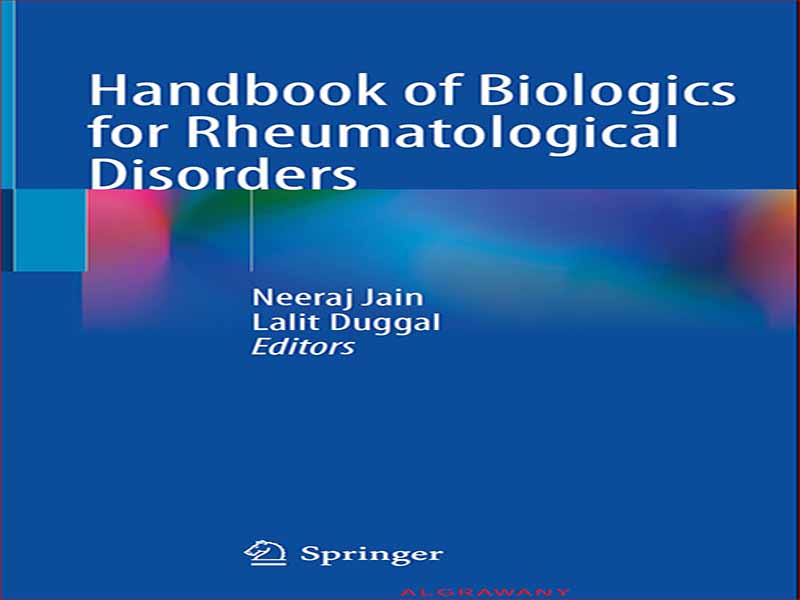- عنوان کتاب: Handbook of Biologics for Rheumatological Disorders
- نویسنده: Neeraj Jain
- حوزه: روماتولوژی
- سال انتشار: 2022
- تعداد صفحه: 286
- زبان اصلی: انگلیسی
- نوع فایل: pdf
- حجم فایل: 4.74 مگابایت
در حالی که فصلها و کتابهای اخیر در مورد روماتولوژی، نوشته و ویرایش شده توسط برادرانمان را مرور میکردیم، بسیار خوشحال بودیم که تصمیم گرفتیم این پروژه را آغاز کنیم. هدف این بود که چیزی متفاوت، مفید و مفید برای مبتدیان و همچنین برای افراد باتجربه در یکی از جنبه های هیجان انگیز و اتفاق افتاده در اختلالات روماتولوژیک یعنی BIOLOGICS نشان دهد. عوامل فوق الذکر عملاً کل طیف رویکرد را در مدیریت این شرایط اغلب دشوار تغییر داده اند. از زمان کشف MABs (آنتی بادی های مونوکلونال) در سال 1975، حدود دو دهه و نیم طول کشید تا اولین مولکول در آرتریت روماتوئید تایید شود. در حدود 10 سال گذشته، انبوهی از این عوامل در زمینه های مختلف روماتولوژی وجود داشته است. آخرین بچه در بلوک، مهارکننده های JAK، به اصطلاح بیولوژیک خوراکی، به آرمنتاریوم اضافه شده است. این رساله تلاشی بدیع برای به تصویر کشیدن کاربرد بیولوژیک «در قفسه و در خط لوله» در بیماری های روماتولوژیک رایج است. این شامل مقدمه ای جذاب به تاریخچه آنها، همراه با نمای چشم پرنده از استفاده از آنها در حضور عفونت ها، بدخیمی ها، جنبه های اخلاقی آنها، استفاده خارج از برچسب آنها، و بیوسیملارها است، که مورد دوم بسیار مقرون به صرفه است. متن نوشته. فصلهای مربوط به بیولوژیک در اختلالات روماتولوژیک کودکان و همچنین در استئوآرتریت و پوکی استخوان به ارزش این کتاب میافزایند. و در نهایت سودمندی آنها در شرایط متنوع و متنوعی مانند یووئیت، سارکوئیدوز، و بیماری نوپای مرتبط با IgG4، به احتمال زیاد، گروه های عمده ای را که این داروها ممکن است اهمیت داشته باشند، تکمیل می کند. این نیست که بیولوژیک ها را به عنوان «همه و همه چیز» درمان در روماتولوژی مطرح کنیم. این یک واقعیت شناخته شده است که روماتولوژیست ها باید در استفاده از آنها بسیار دقت کنند. و به جز اسپوندیلوآرتریت، واسکولیت مرتبط با ANCA، و شاید چند مورد دیگر، استفاده اولیه از آنها در این لحظه از زمان پیش بینی و تایید نشده است. مشارکت انبوهی از استعدادهای پان هندی، همراه با طعم و مزه بین المللی از دانشمندان فرهیخته، ضمن افزودن ارزش به این کتاب، دانش خوانندگان را غنی تر خواهد کرد. امیدواریم این اثر بینظیر، با کاتالوگ مجازی بیولوژیکها، به همه کسانی که به دنبال مرجعی سریع در مورد عملی بودن این «داروهای شگفتانگیز» در زمینه روماتولوژی هستند کمک کند.
It was sheer serendipity, while going through recent chapters and books on rheumatology, written and edited by our brethren, that we decided to embark on this project. The purpose was to bring out something different, handy, and useful for the beginners as well as for the experienced, in one of the most exciting and happening aspects in rheumatological disorders—the BIOLOGICS. The aforementioned agents have virtually transformed the entire spectrum of approach in managing these often difficult to treat conditions. From the discovery of MABs (monoclonal antibodies) in 1975, it took about two and a half decades for the approval of the first molecule in rheumatoid arthritis. In the last 10 years or so, there has been an avalanche of sorts of these agents in various fields of rheumatology. The latest kid on the block, the JAK inhibitors, the so-called oral biologics, have been added to the armamentarium. This treatise is a novel attempt to portray the utility of “on the shelf and in the pipeline” biologics, in common rheumatological diseases. It includes a fascinating introduction to their history, along with a bird’s-eye view of their use in the presence of infections, malignancies, their ethical aspects, their off-label use, and the biosimilars, the latter being so very cost relevant in our context. The chapters on biologics in pediatric rheumatologic disorders as well as in osteoarthritis and osteoporosis add value to this book. And finally their usefulness in conditions as varied and diverse as uveitis, sarcoidosis, and the nascent IgG4-related disease will, in all likelihood, complete the major groups where these drugs may be of importance. It is not to project the biologics as the “be-all and end-all” of treatment in rheumatology. It is a known fact that rheumatologists have to tread very carefully in their use. And except for spondyloarthritis, ANCA-associated vasculitis, and perhaps a few other conditions, their upfront use is not projected and approved at this moment of time. Contributions from the plethora of pan-India talent, along with a sprinkling of international flavor of erudite scholars, while adding value to this book, will further enrich the knowledge of the readers. We hope, this one of a kind work, with a virtual catalogue of biologics, is of help to all those looking for a quick reference regarding the practicability of these “wonder drugs” in the field of rheumatology.
این کتاب را میتوانید بصورت رایگان از لینک زیر دانلود نمایید.
Download: Handbook of Biologics for Rheumatological Disorders



































نظرات کاربران